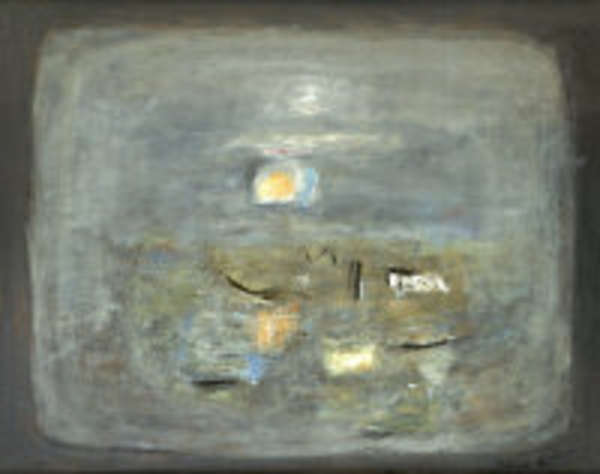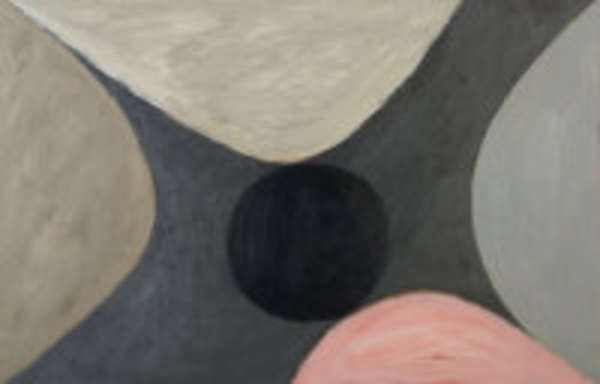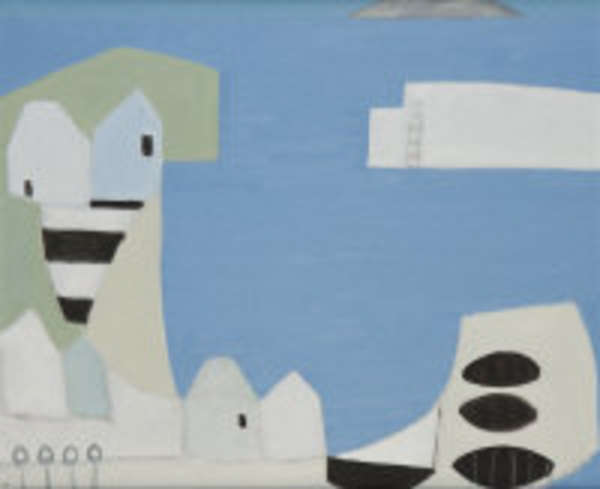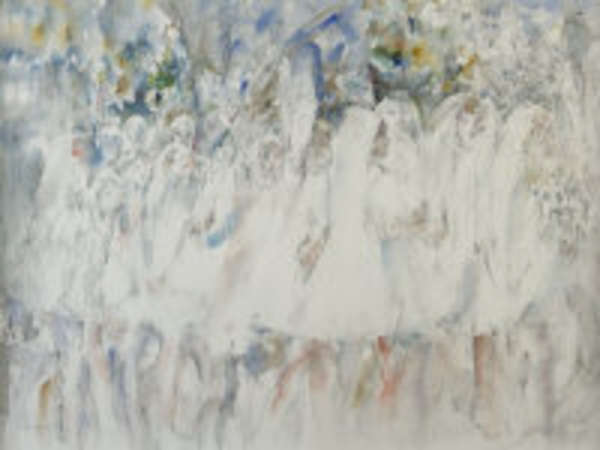Gerard Dillon (1916-1971) Mending Nets, Aran Oil on canvas, 84.3 x 92cm (33.25 x 36.25'') Signed Thought to have been exhibited 'Gerard Dillon Exhibition' The Dawson Gallery, Dublin, 1971, Cat. No. 4 Cycling around the West of Ireland with his good friend Ernie Atkins in 1939, Dillon was fascinated by a group of three limestone Islands in the mouth of Galway Bay. He returned to the Aran Islands in 1943 and 1944, where he would have known Elizabeth Rivers (1903-64) who had been living on Inis M?r. Both artists observed the culture and character of the people, and in doing this, must also have been conscious of being outsiders on these Irish-speaking Islands. Elizabeth Rivers was born in England, and Dillon lived most of his life in the urban environments of London, Dublin and his native Belfast. Perhaps, it was this sense of difference that attracted other Northern Irish artists, Paul Henry James Humbert Craig and Charles Lamb to the area, a world geographically close but socially and physically completely different. Gerard Dillon produced several paintings from his visits to the Aran Islands. These include ''Turf Boats'', (Kilronan, Inis M?r), ``Island couple''(Inis Me?in), ''Aran Islanders in Their Sunday Best'' and ''Sunday Afternoon, Aran Islands''. ''Mending Nets, Aran'' would appear to be from this period of work. Dillon depicts the Fishermen on a pier, taking a break from mending their nets. The scarcity of fertile soil on the rocky islands meant that the sea could always be relied upon for a source of food. Fishermen caught a wide range of fish including Cod, Whiting, Mackerel, Dory, Pollack and seasonally Lobster and Prawns. The three men are in traditional dress style of the Aran Islands; wearing the wide-legged homespun trousers that were worn with oiled wool jerseys. The Jerseys, now known as the ''Aran Sweater'', were knitted by women in the family with undyed homespun wool to help their husbands or sons weather the often-treacherous island conditions. Each family had their own distinct decorative stitch which also had its own meaning, and the islanders could identify a fisherman by this stitch in fishing accidents. Over the jerseys, the men are wearing double-breasted waistcoats, also know as b?in?n jackets, or short coats of light, undyed homespun flannel without collar or pockets. Their shoes are made of a single piece, or single sole known as ''Pampouties''. These were made from rawhide, which prevented the men from slipping in their currachs. Footwear had a lifespan of about a month and required soaking in water to keep them supple. Their belts, (cris) were colourful, and were made from coloured wools woven without a loom. The Fisherman gazing out at the Galway Hooker is wearing a knitted cap with a woolen bob known as a ''bubbel?n''. This figure echoes another painting from the same period entitled ''The Kelp Gatherers'', emphasizing the Islander's daily lives, which were intimately intertwined with land and sea. Below, in the harbour a currach sets out for the open sea. These were traditionally made of tarped canvas over a wooden frame, and great skill was required to handle these boats, as Dillon later discovered in 1951, when he lived on Inishlackan Island, a mile off Roundstone in the Atlantic ocean. In March 1971, an exhibition of Gerard Dillon's early 1940's and 50's paintings of the West of Ireland was held at the Dawson Gallery, Dublin. A painting entitled ''Mending Nets, Aran'' is listed as No. 4. James White wrote in the catalogue ''?He became enraptured by the reality of the people, farming, fishing, drinking and dancing. He translated it all into visual images as Synge had earlier translated it into words and the drama''. Karen Reihill is currently researching the Life and work of Gerard Dillon Gerard Dillon (1916-1971) Mending Nets, Aran Oil on canvas, 84.3 x 92cm (33.25 x 36.25'') Signed Thought to have been exhibited 'Gerard Dillon Exhibition' The Dawson Gallery, Dublin, 1971, Cat. No. 4 Cy
Gerard Dillon (1916-1971) Mending Nets, Aran Oil on canvas, 84.3 x 92cm (33.25 x 36.25'') Signed Thought to have been exhibited 'Gerard Dillon Exhibition' The Dawson Gallery, Dublin, 1971, Cat. No. 4 Cycling around the West of Ireland with his good friend Ernie Atkins in 1939, Dillon was fascinated by a group of three limestone Islands in the mouth of Galway Bay. He returned to the Aran Islands in 1943 and 1944, where he would have known Elizabeth Rivers (1903-64) who had been living on Inis M?r. Both artists observed the culture and character of the people, and in doing this, must also have been conscious of being outsiders on these Irish-speaking Islands. Elizabeth Rivers was born in England, and Dillon lived most of his life in the urban environments of London, Dublin and his native Belfast. Perhaps, it was this sense of difference that attracted other Northern Irish artists, Paul Henry James Humbert Craig and Charles Lamb to the area, a world geographically close but socially and physically completely different. Gerard Dillon produced several paintings from his visits to the Aran Islands. These include ''Turf Boats'', (Kilronan, Inis M?r), ``Island couple''(Inis Me?in), ''Aran Islanders in Their Sunday Best'' and ''Sunday Afternoon, Aran Islands''. ''Mending Nets, Aran'' would appear to be from this period of work. Dillon depicts the Fishermen on a pier, taking a break from mending their nets. The scarcity of fertile soil on the rocky islands meant that the sea could always be relied upon for a source of food. Fishermen caught a wide range of fish including Cod, Whiting, Mackerel, Dory, Pollack and seasonally Lobster and Prawns. The three men are in traditional dress style of the Aran Islands; wearing the wide-legged homespun trousers that were worn with oiled wool jerseys. The Jerseys, now known as the ''Aran Sweater'', were knitted by women in the family with undyed homespun wool to help their husbands or sons weather the often-treacherous island conditions. Each family had their own distinct decorative stitch which also had its own meaning, and the islanders could identify a fisherman by this stitch in fishing accidents. Over the jerseys, the men are wearing double-breasted waistcoats, also know as b?in?n jackets, or short coats of light, undyed homespun flannel without collar or pockets. Their shoes are made of a single piece, or single sole known as ''Pampouties''. These were made from rawhide, which prevented the men from slipping in their currachs. Footwear had a lifespan of about a month and required soaking in water to keep them supple. Their belts, (cris) were colourful, and were made from coloured wools woven without a loom. The Fisherman gazing out at the Galway Hooker is wearing a knitted cap with a woolen bob known as a ''bubbel?n''. This figure echoes another painting from the same period entitled ''The Kelp Gatherers'', emphasizing the Islander's daily lives, which were intimately intertwined with land and sea. Below, in the harbour a currach sets out for the open sea. These were traditionally made of tarped canvas over a wooden frame, and great skill was required to handle these boats, as Dillon later discovered in 1951, when he lived on Inishlackan Island, a mile off Roundstone in the Atlantic ocean. In March 1971, an exhibition of Gerard Dillon's early 1940's and 50's paintings of the West of Ireland was held at the Dawson Gallery, Dublin. A painting entitled ''Mending Nets, Aran'' is listed as No. 4. James White wrote in the catalogue ''?He became enraptured by the reality of the people, farming, fishing, drinking and dancing. He translated it all into visual images as Synge had earlier translated it into words and the drama''. Karen Reihill is currently researching the Life and work of Gerard Dillon Gerard Dillon (1916-1971) Mending Nets, Aran Oil on canvas, 84.3 x 92cm (33.25 x 36.25'') Signed Thought to have been exhibited 'Gerard Dillon Exhibition' The Dawson Gallery, Dublin, 1971, Cat. No. 4 Cy















Try LotSearch and its premium features for 7 days - without any costs!
Be notified automatically about new items in upcoming auctions.
Create an alert